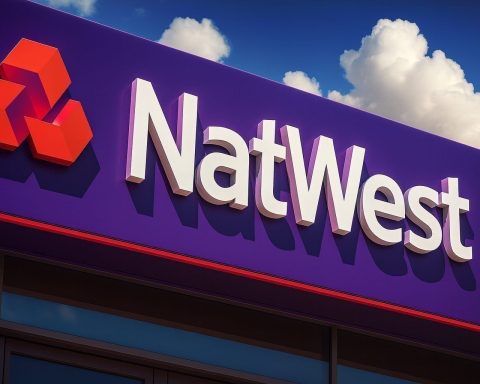LONDON – 27 November 2025 – NatWest Group Plc (LON: NWG) is closing out a pivotal week for UK banks with its share price continuing to climb and a flurry of announcements spanning start‑up support, social housing and technology lending.
- NWG share price closed at 623.6p in London on Thursday, up 0.8% on the day and almost 8% higher than last Friday’s close, near the top of its 52‑week range of 369p–626.6p. [1]
- The move extends gains after Chancellor Rachel Reeves’ Budget confirmed no new taxes on banks, triggering a rally in the sector earlier this week. [2]
- New press release today: NatWest has signed four university partnerships (Oxford, Manchester, Brighton and York), surpassed its 10,000‑member accelerator target, and opened a new flagship hub at its 250 Bishopsgate HQ. [3]
- Housing association VIVID has secured a £100m loan from NatWest as part of the bank’s £500m social loan fund to accelerate the delivery of homes for social rent. [4]
- CloudClevr, a UK managed services provider, has agreed a long‑term financing package with NatWest to fund both organic growth and acquisitions. [5]
- These moves sit on top of record Q3 2025 profits, new climate‑finance targets and 2027 return goals, underscoring NatWest’s effort to define its post‑bailout story after the UK government fully exited its shareholding in May. [6]
NatWest share price today: NWG edges higher after Budget rally
NatWest Group shares closed at 623.6p on the London Stock Exchange on Thursday, up 0.84% on the session. That puts the stock within touching distance of its 52‑week high at 626.6p, and roughly 7.7% above last Friday’s close around 579p. [7]
The gains build on Tuesday and Wednesday’s sharp rally, when UK lenders jumped after reports – later confirmed in the Budget – that the Labour government would not impose a new windfall tax on bank profits or additional levies on interest earned from Bank of England reserves. [8]
Reuters notes that NatWest shares leapt around 2.5% on Wednesday after the Budget, outpacing the FTSE 100, as investors breathed a sigh of relief that long‑mooted extra taxes on banks had been shelved for now. [9]
An analysis piece from Investing.com/Invezz adds that NatWest stock has now risen about 75% from its low earlier this year, helped by robust earnings and expectations of generous shareholder returns. [10]
For investors, today’s modest move looks more like consolidation after a big policy‑driven re‑rating than the start of a new leg higher – but it comes alongside fresh evidence that NatWest is still deploying capital into its preferred growth and ESG themes.
Four new university partnerships and a bigger NatWest Accelerator
The headline corporate news from NatWest today is its new push into university‑linked entrepreneurship.
In a press release dated 27 November, the bank announced that it has signed “Entrepreneur” partnerships with the Universities of Manchester, Brighton and York, and joined Equinox, an economic‑growth initiative led by the University of Oxford. [11]
Key elements include:
- NatWest has exceeded its 2025 goal of building a 10,000‑strong Accelerator community and plans to expand that network again in 2026. [12]
- The partnerships are designed to support early‑stage spin‑outs, student founders and scaling businesses, with the bank aiming to sign six more university partnerships by the end of 2027. [13]
- At York and Brighton, NatWest will create on‑site Accelerator hubs, giving founders workspace, mentoring and export support, adding to its existing 12‑hub UK network. [14]
- New data released with the announcement claims that businesses going through NatWest’s Accelerator grow turnover by 104% a year on average, compared with around 20% in a control group, and that nine in ten are still trading three years later – more than double the survival rate of the comparison group. [15]
The bank also unveiled a new flagship Accelerator hub at its London headquarters at 250 Bishopsgate, opened by CEO Paul Thwaite and hosting the second‑round final of the NatWest Accelerator Pitch competition, which will distribute £100,000 in prize funding in this round alone. [16]
For a bank still fighting to improve its reputation with small businesses after the RBS restructuring years, the message is clear: NatWest wants to be seen as the go‑to bank for UK founders and university spin‑outs, not just a big retail lender.
£100m for VIVID: social housing loan under £500m fund
On the housing side, NatWest’s purpose narrative today is anchored by VIVID, one of southern England’s largest housing associations.
A fresh press item from VIVID confirms that the organisation has secured £100m in funding from NatWest under the bank’s £500m social loan fund, which is explicitly aimed at accelerating the delivery of homes for social rent. [17]
Back in July, NatWest launched this ring‑fenced £500m pool of lending for housing associations, offering no arrangement fees and discounted margins for building new social rent homes across the UK. [18]
The deal with VIVID marks one of the first, and largest, deployments from that pool and builds on earlier NatWest support, including a £125m funding package announced in July to help VIVID build about 400 new affordable, energy‑efficient homes. [19]
NatWest is already one of the UK’s biggest lenders to the social housing sector and has committed to lend £7.5bn to housing associations by the end of 2026, up from an earlier £5bn target. [20]
For investors trying to understand the bank’s ESG profile, the VIVID deal underlines three things:
- NatWest is happy to deploy capital into long‑dated, lower‑risk social housing assets that also tick climate and affordability boxes.
- It is using thematic pools of funding – like the £500m social loan fund and its separate climate‑finance framework – to signal strategic priorities to both regulators and shareholders. [21]
- Housing remains a politically sensitive area; strong visibility in funding new social rent stock may help offset criticism around branch closures and profitability.
CloudClevr funding shows continued push into UK tech and TMT
Away from bricks and mortar, NatWest is also putting fresh money to work in the UK’s tech sector.
Technology Reseller today reports that CloudClevr, a converged managed services provider backed by Rigby Technology Investments, has agreed a long‑term financing partnership with NatWest. [22]
- The funding structure is designed to support both organic growth and acquisition‑led expansion, as CloudClevr rolls up IT, communications and cloud services businesses under one national platform.
- CloudClevr’s proprietary Clevr360 platform offers customers visibility and control across their IT and cloud environments, positioning the company for further scale. [23]
- NatWest’s large‑corporate team describes the deal as a “tailored funding package” that strengthens its broader relationship with the Rigby Group and underlines the bank’s ambition to be a leading lender to TMT (technology, media and telecoms) businesses. [24]
Taken together with the university Accelerator push, today’s CloudClevr announcement reinforces the narrative of NatWest as a banker to the UK’s innovation economy, not just to homeowners and high‑street SMEs.
Branch closures keep the physical footprint in the spotlight
While NatWest talks up its new campuses and hubs, the shrinking high‑street presence remains a sore point for many communities – and it’s back in the headlines again today.
A January report from Credit Strategy highlighted that NatWest planned to close 53 branches in 2025, following years of network reductions. Since 2015, the wider NatWest Group – including Royal Bank of Scotland and Ulster Bank – has closed 1,409 branches, against a backdrop of more than 6,100 UK bank and building‑society closures across the industry. [25]
The article also noted that NatWest now serves over 19 million customers, with at least 3.5 million using online banking, and that regulators require banks to conduct detailed impact assessments and ensure customers retain access to cash – often via shared “banking hubs” run through the Post Office. [26]
Today, UK tabloid coverage is again focusing on the issue, with The Sun reporting that NatWest and Royal Bank of Scotland plan to axe a further 46 branches, continuing a tough trend for face‑to‑face banking in some towns. [27]
For NatWest, the tension is obvious:
- On one hand, digital adoption and cost pressures make a leaner branch footprint almost unavoidable.
- On the other, the bank is trying to project itself as a community‑minded lender – funding social homes, university entrepreneurs and tech jobs – while reducing physical services in many communities.
Expect scrutiny of how convincingly NatWest balances those stories in 2026 and beyond.
Strategy backdrop: record profits, climate goals and 2027 targets
Today’s announcements sit on top of a materially improved financial and strategic backdrop for NatWest in 2025.
Record Q3 profits and upgraded guidance
In late October the bank reported its highest quarterly profits since the 2008 crisis, with £2.2bn in pre‑tax profit for Q3 2025, up from £1.7bn a year earlier and ahead of analyst expectations. Total income grew to about £4.3bn (versus £3.7bn a year earlier), supported by a £4.4bn increase in lending, including £1.7bn of new mortgages. [28]
NatWest’s net interest margin – a key profitability metric – reached around 2.37%, and its CET1 capital ratio stood at 14.2%, above the top of its 13–14% target range, helped by £2.2bn of risk‑weighted‑asset management actions. [29]
These results allowed management to raise 2025 profitability guidance and target a return on tangible equity above 18% for the year, contributing to the re‑rating in the share price over the autumn. [30]
Long‑term targets and shareholder returns
Looking further out, NatWest has outlined 2027 targets that include:
- RoTE of more than 15%;
- Maintaining a CET1 ratio between 13% and 14%;
- From 2025 onwards, ordinary dividends of around 50% of attributable profit, with share buybacks considered when conditions allow. [31]
Those goals help explain investor enthusiasm – particularly when combined with the Budget decision not to raise bank‑specific taxes, which removes one of the biggest overhangs on the UK banking sector for now. [32]
Climate and transition finance
Strategically, NatWest is also reshaping itself around climate commitments:
- It hit its previous £100bn Climate & Sustainable Funding and Financing target early in Q1 2025, and has now set a new goal to provide £200bn of Climate and Transition Finance between 1 July 2025 and the end of 2030, under a revamped framework that explicitly backs both green solutions and transition projects in high‑emitting sectors. [33]
- On its own operations, the bank reached its 2025 emissions‑reduction goal a year ahead of schedule, cutting direct operational emissions by 51% versus a 2019 baseline by 2024. It now aims to reduce Scope 1 and location‑based Scope 2 emissions by 70% and Scope 3 by 50% by 2030, with supply‑chain emissions already down 40% since 2019. [34]
The £100m social loan to VIVID, in this context, is not just another corporate deal – it’s a visible deployment of NatWest’s climate and social‑impact ambitions, connecting affordable housing, energy‑efficient building and long‑term finance.
Fully private again after 17 years
Finally, 2025 is the year NatWest fully escaped state ownership.
On 30 May, the UK government sold its remaining shares, ending a 17‑year chapter that began with a £45–46bn bailout of the then‑RBS at the height of the financial crisis. The state once owned 84% of the bank, but exited with roughly £35bn recouped, implying a loss to taxpayers of about £10.5bn. [35]
NatWest’s own H1 2025 results emphasised that, having returned to full private ownership in Q2, the group delivered £2.5bn in attributable profit, earnings per share of 30.9p and a RoTE of about 18%, positioning it to “step up” its role in supporting UK growth. [36]
That new freedom helps explain why the bank is so keen to show visible progress in entrepreneurship, ESG and regional investment – and why investors are paying close attention to how it allocates capital.
What today’s news means for NatWest investors
For shareholders and prospective investors, the 27 November news flow reinforces several themes:
- Operational momentum remains strong. The share price sitting near a 52‑week high, even after a huge run from the lows, reflects not just the Budget relief but also genuinely robust earnings and upgraded guidance. [37]
- Capital is being deployed into policy‑aligned areas – social rent housing, climate transition, university spin‑outs and digital infrastructure – that are likely to stay high on the political agenda, which could be helpful as banks defend their social licence. [38]
- ESG credibility is strengthening, with early achievement of operational emissions targets and a much larger climate‑finance ambition, though investors will still want to monitor how profitable these activities are relative to traditional lending. [39]
- Reputational and political risks haven’t vanished. Branch closures and past conduct issues continue to attract criticism, and future Budgets could yet revisit bank taxation if economic conditions change. [40]
Overall, today’s developments support the view that NatWest is leaning into its new, fully private era with a mix of growth initiatives and purpose‑led lending, even as it navigates the inevitable trade‑offs of a leaner high‑street presence and a still‑sceptical public.
This article is for information only and does not constitute investment, tax or legal advice. Always do your own research or consult a qualified adviser before making investment decisions.
References
1. www.investing.com, 2. www.reuters.com, 3. www.natwestgroup.com, 4. www.vividhomes.co.uk, 5. technologyreseller.uk, 6. www.ft.com, 7. www.investing.com, 8. uk.investing.com, 9. www.reuters.com, 10. uk.investing.com, 11. www.natwestgroup.com, 12. www.natwestgroup.com, 13. www.natwestgroup.com, 14. www.natwestgroup.com, 15. www.natwestgroup.com, 16. www.natwestgroup.com, 17. www.vividhomes.co.uk, 18. www.natwestgroup.com, 19. www.natwestgroup.com, 20. www.natwestgroup.com, 21. www.natwestgroup.com, 22. technologyreseller.uk, 23. technologyreseller.uk, 24. technologyreseller.uk, 25. www.creditstrategy.co.uk, 26. www.creditstrategy.co.uk, 27. www.thesun.co.uk, 28. www.ft.com, 29. investors.natwestgroup.com, 30. www.ft.com, 31. www.gurufocus.com, 32. www.reuters.com, 33. www.natwestgroup.com, 34. www.natwestgroup.com, 35. www.gov.uk, 36. www.natwestgroup.com, 37. www.investing.com, 38. www.natwestgroup.com, 39. www.natwestgroup.com, 40. www.creditstrategy.co.uk










